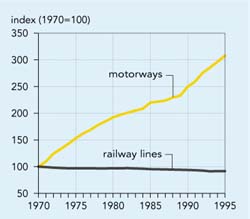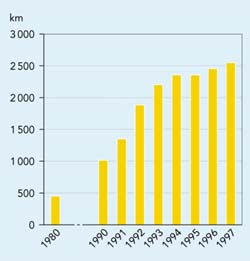Indicator 12: Capacity of infrastructure networks
- In EU countries the length of the road network
has continued to increase. By 1996 the total EU road network amounted
to 3.5 million km. The fastest growth was in the motorway network
nearly doubling between 1970 and 1996 to 46 000 km.
- At the same time the length of railway lines
and inland waterways decreased by some 8 %.
Figure 4.2: Length of motorways and railways (EU 15)

Source: Eurostat
Objectives
- Optimise
use of existing infrastructure capacity.
- Revitalise rail and inland waterways.
Definition
Proxy indicator for capacity: length
of transport infrastructure by type (e.g. motorways, roads, railways and
navigable inland waterways).
|
Policy and targets
The TEN plans cover major road, rail (both conventional
and High Speed Rail HSR), inland waterways, maritime ports, airports and combined
networks. They include plans for some 27 000 km of motorways (of which
around 54 % will be upgradings of existing roads and 46 % will be
new roads), 10 000 km of new high-speed rail tracks, and 14 000 km
of conventional rail to be upgraded to high-speed rail tracks. It also includes
investments in intelligent transport systems (i.e. Global Navigation Satellite
Systems and traffic management systems for different modes).
Additional initiatives to promote railways include
the launch of freight freeways (CEC, 1997a) and the implementation of Directive
96/48/EC on the interoperability of the trans-European high-speed rail system.
Steps are also being taken to implement the Commissions 1996 White for revitalising
the Communitys railways (CEC, 1996b).
Following its Communication on intermodal freight
transport (CEC, 1997b), the Commission has proposed new rules for combined transport
(COM/98/414 final) and will develop proposals and actions to encourage intermodal
transport.
Some Member States have set targets for transport
infrastructure. The Netherlands aims to improve rail services by increasing
the axle loads which can be carried (VENW, 1989). The cycling strategy of
the United Kingdom is expected to result in doubled cycling rates by 2002, with
a corresponding network improvement (DETR, 1996).
Findings
There has been a steady increase in the length
of the road network. By 1996 the total length of EU road infrastructure amounted
to about 3.5 million km. Between 1970 and 1996, the length of railway lines
and inland waterways decreased by about 8 %.less only 7 % over 15
years from 1980.
The primary road network now includes about 46
300 km of motorways and 222 300 km of national roads. Between 1970 and 1996
motorway length increased by 4.4 % per year. In Belgium, Denmark, Ireland,
Luxembourg and the UK the length of other roads increased much
The TEN road network includes some 74 500 km
of motorways and main inter-urban roads, of which 27 000 km are planned
for completion by 2010. Although the TEN road network accounts for only one
quarter of the EU primary network, its use is proportionally much higher. For
example, in Germany and Denmark, it carries about one-third of road passenger
traffic and in the UK, about half of freight transport (tonne-km).
The growth in road infrastructure varies between
countries. In Belgium the total length of state, provincial and community roads
increased by 15 % between 1980 and 1995 by gradual extensions of local
and regional networks. In the same period the road network in Ireland diminished
slightly (by about 1 %).
Road network densities in the Netherlands and
Belgium are high, reflecting high population densities and mobility levels.
Sweden and Spain have relatively low road network density, reflecting low population
densities. Road length per head is highest in Ireland, Finland and Austria and
lowest in Spain, Italy and the UK.
In 1996, the rail network length was about 166 000
km of which 48 % was electrified. Some 78 600 km of these form part
of the TEN. Although the length of railways has been falling for several decades,
it is difficult to estimate the effect on capacity. Minor lines have been closed,
but the length of high-speed rail track increased by 150 % between 1990
and 1997. Today the HSR network has grown to more than 2 800 km of high capacity
high-speed track.
The highest level of rail infrastructure per
head is in Sweden where a high share of freight transport is by rail. Italy
and Greece have low levels of rail infrastructure per head, and low levels of
passenger and freight rail transport.
The inland waterways network is about 30 000
km long.
Figure 4.3: Length of high-speed railways in the EU

Source: Eurostat
|
Box 4.1: The European Cycle Route Network
A European cycle route network is under development
under an initiative of the European Cyclists Federation. It is designed
to promote cycling by providing facilities for local work and recreational
use, as well as for tourists.
Linking European cities will need new infrastructure,
but much of the network will use existing national, regional and local
routes. The first route is expected to open in the spring of 2000 with
a new route added each year until 2011.
As well as providing cycle infrastructure, the
EuroVelo project includes marketing, educational and attitudinal initiatives
to change the current transport culture. It aims to help national and
regional governments shift transport demand away from private car use.
Source: European Cyclists Federation.
|
Future work
- Further work is required at the EU level to develop
reliable and comparable statistics on infrastructure by mode and type. In
particular, definitions of road categories need to be harmonised as Member
States have different administrative arrangements and classifications.
- Additional data on infrastructure and operation characteristics
(e.g. number of lanes, number of tracks, frequency of trains, etc.) is needed
to develop the current length indicator into a capacity supply indicator.
- Data also needs to be collected on public transport
infrastructure and services, combined transport infrastructure and bicycle
lanes.
Data
The length of infrastructure per inhabitant (1996)
Unit: km/million inhabitants |
|
|
Motorways |
National roads
|
State roads |
Municipal roads
|
Total roads |
Railways |
Pipelines |
Inland waterways
|
|
Austria
|
199 |
1 274 |
2 454 |
12 157 |
16 084 |
704 |
96 |
44 |
|
Belgium
|
165 |
1 241 |
131 |
12 654 |
14 190 |
333 |
29 |
151 |
|
Denmark
|
167 |
701 |
1 347 |
11 400 |
13 616 |
446 |
78 |
- |
|
Finland
|
84 |
2 407 |
5 673 |
7 012 |
15 177 |
1 148 |
- |
1 219 |
|
France
|
142 |
460 |
6 169 |
9 747 |
16 519 |
546 |
83 |
97 |
|
Germany
|
138 |
506 |
2 177 |
5 109 |
7 931 |
498 |
41 |
90 |
|
Greece
|
45 |
869 |
2 779 |
7 217 |
10 909 |
236 |
- |
- |
|
Ireland
|
22 |
1 501 |
3 223 |
21 679 |
26 425 |
776 |
- |
- |
|
Italy
|
112 |
780 |
1 975 |
2 474 |
5 341 |
279 |
74 |
26 |
|
Luxembourg
|
277 |
2 299 |
4 571 |
5 581 |
12 728 |
660 |
- |
89 |
|
Netherlands
|
152 |
137 |
553 |
7 342 |
8 183 |
176 |
25 |
325 |
|
Portugal
|
72 |
910 |
4 646 |
6 297 |
11 923 |
287 |
- |
- |
|
Spain
|
186 |
449 |
1 794 |
1 709 |
4 138 |
313 |
94 |
- |
|
Sweden
|
150 |
1 657 |
9 430 |
4 400 |
15 637 |
1 235 |
- |
n.a. |
|
United Kingdom
|
57 |
210 |
648 |
5 769 |
6 684 |
289 |
44 |
40 |
|
EU15
|
124 |
596 |
2 673 |
5 970 |
9 363 |
419 |
55 |
81 |
|
Source: DG Transport, Eurostat
Note: Figures for Ireland updated with
data from Irelands Central Statistics Office Data on pipelines refer
to 1995
|


Document Actions
Share with others